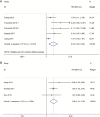Preoperative D-dimer level is an independent prognostic factor for non-small cell lung cancer after surgical resection: a systematic review and meta-analysis
- PMID: 31555680
- PMCID: PMC6736809
- DOI: 10.21037/atm.2019.05.35
Preoperative D-dimer level is an independent prognostic factor for non-small cell lung cancer after surgical resection: a systematic review and meta-analysis
Abstract
Background: Whether high preoperative D-dimer level has any impact on long-term survival of patients with surgically treated non-small cell lung cancer (NSCLC) remains unclear. Therefore, we conducted the first meta-analysis focusing specifically on prognostic value of high preoperative D-dimer level in NSCLC patients after surgical resection comprehensively.
Methods: We conducted a systematic search for relevant studies in PubMed, Embase, and Web of Science on January 28, 2019. Data for analysis consisted of hazard ratio (HR) with 95% confidence interval (CI) of overall survival (OS) and disease-free survival (DFS) from multivariate analysis and were analyzed by using the STATA 12.0 package.
Results: Finally, we included a total of 6 cohort studies consisting of 1,817 patients with surgically treated NSCLC for analysis. Our meta-analysis found that NSCLC patients with high preoperative D-dimer level had a significantly worse OS (random effects: HR =2.04; 95% CI: 1.30-3.20; P=0.002; I2=67.4%) and DFS (fixed effects: HR =1.98; 95% CI: 1.41-2.78; P<0.001; I2=0.0%) than these with normal preoperative D-dimer level after surgery. However, potential heterogeneity and publication bias was observed during analysis.
Conclusions: High pretreatment level of D-dimer remains to be an independent predictor of poor prognosis in NSCLC patients after surgery. Further well-conducted studies with appropriate adjustments are needed to confirm and update our conclusions.
Keywords: D-dimer; meta-analysis; non-small cell lung cancer (NSCLC); prognosis; surgery.
Conflict of interest statement
Conflicts of Interest: The authors have no conflicts of interest to declare.
Figures




Similar articles
-
High pretreatment D-dimer level is an independent unfavorable prognostic factor of small cell lung cancer: A systematic review and meta-analysis.Medicine (Baltimore). 2021 Apr 16;100(15):e25447. doi: 10.1097/MD.0000000000025447. Medicine (Baltimore). 2021. PMID: 33847650 Free PMC article.
-
Sarcopenia is an independent unfavorable prognostic factor of non-small cell lung cancer after surgical resection: A comprehensive systematic review and meta-analysis.Eur J Surg Oncol. 2019 May;45(5):728-735. doi: 10.1016/j.ejso.2018.09.026. Epub 2018 Oct 15. Eur J Surg Oncol. 2019. PMID: 30348603
-
Preoperative sarcopenia is a predictor of poor prognosis of esophageal cancer after esophagectomy: a comprehensive systematic review and meta-analysis.Dis Esophagus. 2019 Mar 1;32(3):doy115. doi: 10.1093/dote/doy115. Dis Esophagus. 2019. PMID: 30496385
-
Prognostic Value of Pretreatment D-Dimer Level in Small-Cell Lung Cancer: A Meta-Analysis.Technol Cancer Res Treat. 2021 Jan-Dec;20:1533033821989822. doi: 10.1177/1533033821989822. Technol Cancer Res Treat. 2021. PMID: 33563114 Free PMC article.
-
Diabetes mellitus and survival of non-small cell lung cancer patients after surgery: A comprehensive systematic review and meta-analysis.Thorac Cancer. 2019 Mar;10(3):571-578. doi: 10.1111/1759-7714.12985. Epub 2019 Jan 31. Thorac Cancer. 2019. PMID: 30706684 Free PMC article.
Cited by
-
D-Dimers Variability in the Perioperative Period of Breast Cancer Surgery Helps to Predict Cancer Relapse: A Single-Centre Prospective Study.Cancer Control. 2023 Jan-Dec;30:10732748231204713. doi: 10.1177/10732748231204713. Cancer Control. 2023. PMID: 37791647 Free PMC article.
-
The sodium/D-dimer ratio predicts the effect of first-line chemotherapy and prognosis in patients with advanced gastric cancer.Am J Transl Res. 2021 Feb 15;13(2):792-802. eCollection 2021. Am J Transl Res. 2021. PMID: 33594327 Free PMC article.
-
A Nomogram Combining Neutrophil-to-Lymphocyte Ratio and D-Dimer Predicts Chemosensitivity of Oxaliplatin-Based First-Line Chemotherapy in Patients with Unresectable Advanced Gastric Cancer.Technol Cancer Res Treat. 2022 Jan-Dec;21:15330338221112741. doi: 10.1177/15330338221112741. Technol Cancer Res Treat. 2022. PMID: 35880288 Free PMC article.
-
Dynamics of D-dimer in non-small cell lung cancer patients receiving radical surgery and its association with postoperative venous thromboembolism.Thorac Cancer. 2020 Sep;11(9):2483-2492. doi: 10.1111/1759-7714.13559. Epub 2020 Jul 13. Thorac Cancer. 2020. PMID: 32657038 Free PMC article.
-
Pre-Chemotherapy D-Dimer Levels as Predictors of Survival Outcomes in Advanced Gastric Cancer.Med Sci Monit. 2025 May 17;31:e947727. doi: 10.12659/MSM.947727. Med Sci Monit. 2025. PMID: 40380762 Free PMC article.
References
LinkOut - more resources
Full Text Sources
